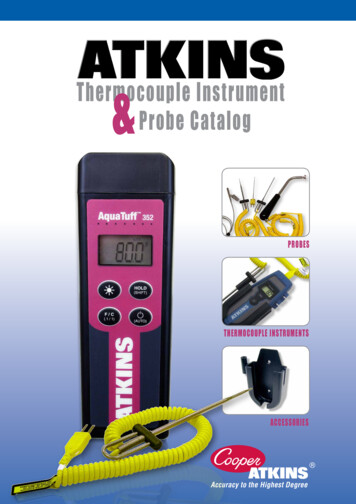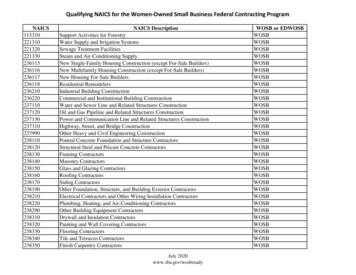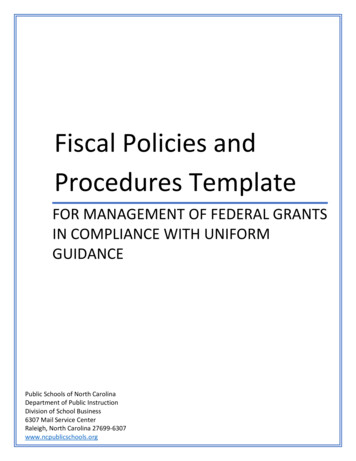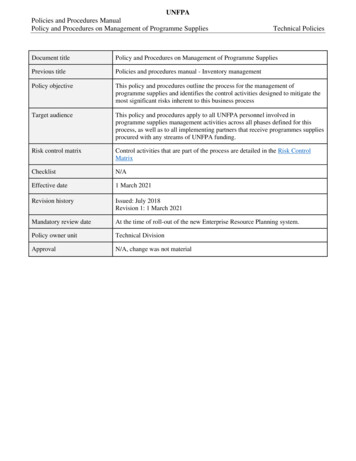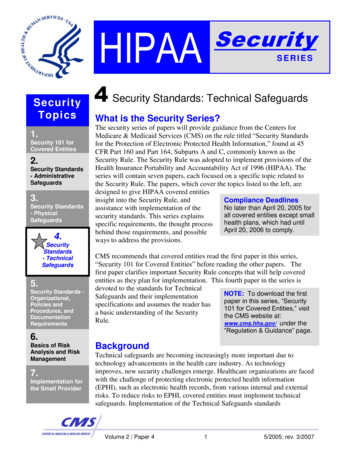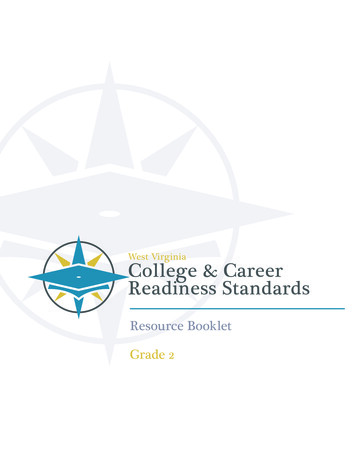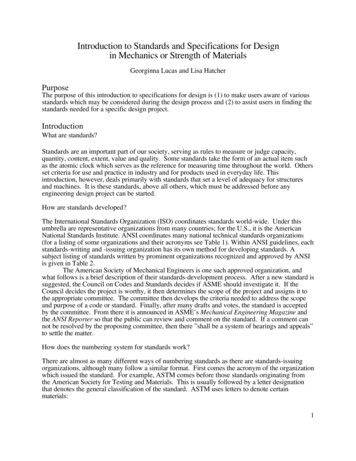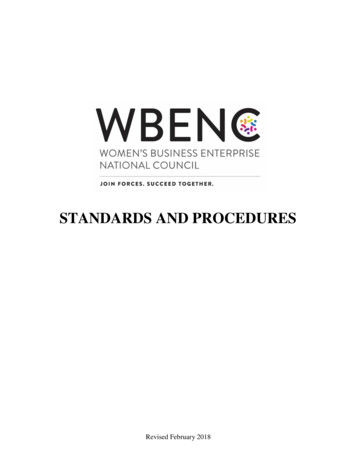
Transcription
STANDARDS AND PROCEDURESRevised February 2018
Table of ContentsI.PURPOSE . 3II.APPLICABILITY . 3III.MARITAL STATUS . 4IV.DISCLOSURE AND CONFIDENTIALITY . 4V.RESPONSIBILITIES . 4VI.NATIONAL CERTIFICATION . 4VII.DEFINITIONS . 4VIII.WBE AND SWBE ELIGIBILITY STANDARDS . 9IX.CERTIFICATION COMMITTEES .16X.CERTIFICATION PROCEDURES .20XI.CERTIFYING EXCEPTIONAL WOMEN’S BUSINESS ENTERPRISES.22XII.CERTIFYING FRANCHISES .25XIII.CHALLENGE PROCEDURES .25XIV.DE-CERTIFICATION PROCESS .27XV.APPEAL PROCESS .27XVI.PROGRAM REVIEW PROCEDURES . 31XVII.NON-ELIGIBLE BUSINESSES .34 WBENC 20182
I.PurposeThe Women’s Business Enterprise National Council, Inc. (“WBENC”) is removingbarriers in the marketplace that impede the progress and growth of businessesowned and managed by women. Key among its programs is nationwide access to anational certification standard, maintenance of a national Women BusinessEnterprise database, WBENCLink, and the enhancement of procurementopportunities through the dissemination of “best practices” information and theprovision of training.It is the policy of the members of WBENC that Women Business Enterprises(WBE) and Small Women Business Enterprises (SWBE) have the maximumpracticable opportunity to participate in contracting and purchasing activities. Theprocedures outlined in this document describe the WBENC certification standardsand process for all businesses desiring to be certified. To the extent possible, athorough certification process will ensure that the programs of these entities benefitonly those for whom the programs are intended.In addition, WBENC is responsible, among other things, for training RegionalPartner Organizations (RPOs), oversight of implementation of the certificationstandards and process, review of its RPO certification programs, and serves as thefinal appellate body.It should be noted that failure to be certified as a Women Business Enterprise orSmall Women Business Enterprise by WBENC DOES NOT PRECLUDE abusiness from participating directly in any of the member entities’ purchasing andcontracting opportunities.The standards established herein are adapted from 49 Code of Federal Regulations(CFR) Part 23 and Part 26.Please refer to Section VII. Definitions for the meanings of capitalized terms usedin this document.II.ApplicabilityThese Standards and Procedures apply to any business seeking status as a WBE.Certification determination will be made on the basis of the gender of the majorityowner(s) and is inclusive of all races and ethnicities.Potential applicants interested in being certified as a WBE should apply withoutwaiting for a conditional contract commitment from a customer. WBENC 20183
III. Marital StatusCertification as a WBE is made without regard to marital status and communityproperty laws.IV. Disclosure and ConfidentialityAll information submitted with the certification affidavit becomes the property ofWBENC. Information that the applicant marks as proprietary or confidential or thatreasonably may be regarded as such will be treated accordingly. The RPO willobtain the applicant’s prior approval to release information submitted that may beconducive to increased opportunities for WBEs. The WBENC certificationaffidavit that is part of the application for certification includes a liability releaseform.V.ResponsibilitiesThe WBENC Board of Directors is ultimately responsible for ensuring thatcertification policies are implemented and enforced. The RPO’s Executive Directoror President has the requisite authority for overall implementation, monitoring andreporting of the RPO’s certification process, and is accountable to the Board ofDirectors of the RPO. In the event of an appeal to WBENC of a denial ofcertification, WBENC Board of Directors holds ultimate responsibility for the finaldetermination. RPO support staff has responsibilities for the day-to-dayimplementation of WBENC’s certification process.VI. National CertificationCertification as a WBE is recognized throughout the WBENC network. All WBEswill be listed in WBENC’s proprietary, internet accessible database, WBENCLink.VII. DefinitionsAffidavit orCertificationAffidavitAn application for certification submitted with a sworn and notarizedStatement of Eligibility, affirming that all information provided is true.AffiliateA person effectively controlled by another person or under commoncontrol with a third person. A branch, division, or subsidiary. Under theInvestment Company Act (15 USCA Section 8a-2), a company in whichthere is ownership (direct or indirect) of five percent (5%) or more of thevoting stock. WBENC 20184
AgentA person authorized to act on behalf of the principal in transactionsinvolving a third party.Agents have three basic characteristics: Act on behalf of and are subject to the control of the principal; They do not have title to the principal’s property; and They own the duty of obedience to the principal’s orders.Agents by their nature are not certifiable.BrokerThe person who acts as an intermediary between a buyer or seller, usuallycharging a commission for value added.A business that adds no material value or does not perform acommercially useful function to the products or services being supplied toa procuring activity or takes no ownership, financial responsibility, legalliability, possession of or handle the item being procured with its ownequipment or facilities will not be certifiable, unless it’s the standard inthe industry.AppealA written request by an applicant to reconsider a determination of denialof certification.ApplicantA business that requests certification as a Women Business Enterprisethrough submission of a certification affidavit.CertificationThe process by which an applicant’s eligibility as a WBE is determined.CertificationCommittee – LocalA committee comprised of volunteers (corporate, government andbusiness owner representatives) who renders recommendations forcertification or denial to the RPO Executive Director or President.CertificationCommittee –NationalA committee of the WBENC Board of Directors responsible for thedevelopment and maintenance of the Standards and Procedures thatgovern the certification process implemented by the RPOs across thenation.Certified SupplierListA listing containing the names of currently certified WBEs maintained byeach RPO. Information found in all local RPO certified supplier lists canalso be found on WBENCLink.ChallengeA formal filing by a third party questioning the eligibility of a certifiedWBE.Contract ComplianceThe enforcement of appropriate use of certification in purchasing andcontracting activities. This function is to be applied by the user entity thatrequires or accepts certification. WBENC 20185
ConsultantOne that gives expert or professional advice for fee or commission.ControlThe power to direct the operation and management of a business.CorporationA specific type of legal entity that is in compliance with the applicablerequirements of the law of its state of incorporation.DealershipAuthorization to sell specified items in a certain area with or withoutexclusivity.De-certificationThe process by which an RPO determines that a WBE no longer meetsthe eligibility requirements and rescinds the certification status.DenialThe action of denying WBE certification to a business that does not meetthe certification eligibility criteria as outlined in these Standards andProcedures.DisadvantagedBusiness EnterpriseAn independent small business enterprise: Which is at least fifty-one percent (51%) owned and controlled by oneor more socially and economically disadvantaged individuals, or inthe case of any publicly owned business, at least fifty-one percent(51%) of the stock of which is owned by one or more socially andeconomically disadvantaged individuals; and Whose management and daily business operations are controlled (asdefined herein), by one or more of the socially and economicallydisadvantaged individuals who own it; and That meets the size standards of 13 CFR Part 121.2 and relevantregulations promulgated thereto.DistributorOne that markets or sells merchandise, i.e. a wholesaler.Document ReviewThe RPO’s review of the affidavit and accompanying documentationsubmitted by an applicant.Eligibility ReviewThe entire review process conducted on an applicant, consisting ofdocumentation review and on-site review.ExceptionalWomen’s BusinessEnterprise (EWBE)Applicants for WBENC certification with revenues in excess of 500M orrequiring specialty certification and/or standard in the industrydetermination and standardization.ExpirationThe specified end of the certification period. WBENC 20186
Financial InstitutionA bank, trust company or other financial institution authorized by law tocarry on a trust business.Financial ReviewThe review of financial records of an applicant.FranchiseA contractual arrangement characterized by the authorization granted tosomeone to sell or distribute a company’s goods or services in a certainarea; a business or group of businesses established or operated under suchauthorization.Industry Standard orStandard in theIndustryThe usual and customary practices in the delivery of products or serviceswithin a particular business sector, i.e. mortgage brokers, insurancebroker, securities brokers.Limited LiabilityCompanyA specific type of legal entity that is in compliance with the applicablerequirements of the law of its state of formation.ManufacturerRepresentativeA person that represents another for or to others, i.e. manufacturer’sgroup. Typically Manufacturer Representatives are not certifiable.MembersAny corporate or governmental entity that is an active participant ofWBENC.NationalCertification ReviewCommitteeAn ad hoc committee of the National Certification Committee, whichreviews files for applicants meeting the definition of EWBE.On-Site ReviewA visit to the applicant’s physical place(s) of business for the verificationof information submitted in the affidavit and accompanyingdocumentation.OwnershipA determination based on title to and beneficial ownership of stock,membership interests, or other equity in a business.PersonAny individual, partnership, joint venture, firm, corporation, limitedliability company, trust or other enterprise.Principal Place ofBusinessThe business location where individuals who manage the business’s dayto-day operations spend most working hours and where top managementbusiness records are kept.PartnershipAn association of two or more persons to carry on, as co-owners, abusiness for profit.Compliance ReviewA scheduled annual review by WBENC of a RPO’s certificationdeterminations and procedures. WBENC 20187
Re-certificationThe process by which a WBE renews certification status prior toexpiration.Regional PartnerOrganization (RPO)A local 501(c)(3) organization recognized by the WBENC as a PartnerOrganization.Regular DealerA business that owns, operates, or maintains a store, warehouse, or otherestablishment in which the materials or supplies are bought, kept in stock,and regularly sold to the public in the usual course of business.ResellerThe act of selling a second time or distributing goods in commerce. Theact of selling used or new products for profit. A business entity thatresells.RetailerThe seller of goods or commodities directly to the consumers at a retailprice.Sole ProprietorshipAn individually owned business whose assets are wholly owned by asingle individual.Strategic AllianceAn association, not a legal entity, of two or more separate businesses thatcome together to pursue business opportunities.SubsidiaryAn entity in which another entity (i.e. the parent) owns at least a majorityof the shares, and thus has control. For example, a corporation more thanfifty percent (50%) of whose voting stock is owned by another.Value AddedSomething that is added to a product or service by a marketer ordistributor that warrant a markup in the retail price.WBENCWomen’s Business Enterprise National Council.Withdrawal ofAffidavitAny business entity may withdraw affidavit without cause, prior to theCertification Committee review, on written request.WholesalerIntermediary or distributor who sells mainly to retailers, other merchantsand industrial commercial and institutional users as distinguished fromconsumers.Woman OwnedSmall Business(WOSB)An entity that is certified as a WOSB and is in complete compliance withits size standard requirement as established by the Small BusinessAdministration (SBA) referred to as 8(m) in the Federal Register. WBENC 20188
Women BusinessEnterprise (WBE)An independent business concern: That is at least fifty-one percent (51%) owned and controlled by oneor more women who are U.S. citizens or lawful permanent residents,or in the case of any publicly-owned business, at least fifty-onepercent (51%) of the equity of which is owned and controlled by oneor more women who are U.S. citizens or lawful permanent residents;and Whose management and daily operation is controlled by one or moreof the women owners.As used in these Standards and Procedures, WBE includes EWBEs, as thecontext requires.VIII. WBE Eligibility StandardsRPOs will use these Standards and Procedures in determining whether an applicantfirm is owned and controlled by women who are US Citizens or lawful permanentresidents, and therefore eligible to be certified as a WBE. Legal entities must beformed in and have their principal place of business in the United States or one ofits territories.In determining eligibility, RPOs must consider all the facts in the record, viewed asa whole, as they appear at the time of the application. An eligible applicant will notbe refused certification based solely on historical information indicating a lack ofownership or control of the applicant by a woman/women at some time in the past,if the applicant currently meets the ownership and control standards.An eligible applicant will not be refused certification solely on the basis that it is anewly formed business.A.Ownership1.The ownership by women must be real, substantial and continuing beyondthe pro-forma ownership of the business as reflected in its ownershipdocuments.2.The applicant must share in all risk and profits commensurate with herownership interest as demonstrated by a detailed examination of thesubstance of her business arrangements with others.3.All securities that constitute majority ownership of a business shall be helddirectly by the woman or women, who are not minors, or held in a trust thatis one of the types of trusts described in Section VIII.A.5.e. Trusts. WBENC 20189
4.Contribution of Capital or Expertise:a. Contribution of capital and/or expertise by women owners to acquiretheir ownership interest shall be real and substantial and be in proportionto the interest(s) acquired.b. Insufficient contributions shall include, but shall not be limited topromises to contribute capital or expertise in the future, a note payableto the business or its owners who are not women, or the mereparticipation as an employee.5.Business Structures and ownership vehicles. Legal entities must be formedin and have their principal place of business in the United States or one ofits territories.a. Sole Proprietori. In a sole proprietorship, the woman must own one hundredpercent (100%) of the company assets.b. Corporationi. In a corporate form of organization, women principal(s) mustown at least fifty-one percent (51%) of each class of voting stockoutstanding and fifty-one percent (51%) of the aggregate of allstock outstanding.ii. Any voting agreements among the shareholders must not dilutethe beneficial ownership, the rights, or the influence of thewomen owners of the stock or classes of stock of thecorporation.iii. Women owners shall possess the right to all customary incidentsof ownership (e.g., ability to transfer stock, title possession,enter binding agreements, etc.).iv. Nonprofit corporations do not meet this requirement and aretherefore not eligible for certification.c. Partnershipsi. General Partnership. In a general partnership, women ownersmust own at least fifty-one percent (51%) of the partnershipinterests.ii. Limited Partnership WBENC 201810
1. In a limited partnership, the women general partnersmust own at least fifty-one percent (51%) of the generalpartnership interest and exert at least fifty-one percent(51%) of the control among general partners. Thewomen general partners must receive at least fifty-onepercent (51%) of the profits and benefits, including taxcredits, deductions and postponements distributed orallocable to the general partner.2. In addition, the women limited partners must own at leastfifty-one percent (51%) of the limited partnershipinterests and receive at least fifty-one percent (51%) ofthe profits and benefits, including tax credits, deductionsand postponements distributed or allocable to the limitedpartners.d. Limited Liability Companiesi. In a Limited Liability Company, Women principal(s) must ownat least fifty-one percent (51%) of membership interests, and atleast fifty-one percent (51%) of the management and controlamong the members.ii. The women principals must also participate in all risks andprofits of the organization at a rate commensurate with theirmembership interests.e. Trustsi. In order to be counted as owned by women, ownership held in atrust must meet the following requirements, as applicable:1. Irrevocable trusts. If the trust is an irrevocable trust,ownership held for the benefit of a woman who is not aminor and who is a beneficiary with a present interest inthe trust may be counted as owned by women.2. Revocable trusts. If the trust is a revocable trust, all thegrantors must be women, and ownership held for thebenefit of a woman who is not a minor and who is abeneficiary with a present interest in the trust may becounted as owned by women.3. ESOPs. Ownership by women who are participants in anemployee stock ownership plan qualified under WBENC 201811
Section 401 of the Internal Revenue Code, 1986, asamended, may be counted as owned by women.4. Trustees. In all cases, all the trustees must be women,provided that a Financial Institution (as defined in theSection VII. Definitions) may act as trustee. (Male cotrustees are not acceptable.)5. Determination of present interest in the trust. Abeneficiary has a present interest in a trust if he or she iscurrently eligible to receive distributions of income orprincipal from the trust. If more than one beneficiary hasa present interest in the trust, each beneficiary shall bedeemed to have an equal interest unless the instrumentthat creates the trust provides otherwise.6. Other requirements. Businesses whose ownership, inwhole or part, is held in a trust are not thereby exemptfrom the other requirements of this Section VIII.B.ControlThe applicant must show evidence that the woman or women owner(s) have controlof the business. “Control” means the primary power to direct the management of abusiness enterprise as evidenced through the governance documents and actual dayto-day operation. The following factors will be examined in determining whocontrols an applicant.1.Governancea. The organizational and governing documents of an applicant (e.g., LimitedLiability Company Operating Agreements, Partnership Agreements, orArticles of Incorporation and By-laws) must not contain any provision,which restricts the ability of the woman/women business owner(s) fromexercising Managerial Control and Operational Authority of the business.b. In reviewing governance documents and issues, special attention shall begiven to:i. The composition of the business’s governing body (e.g., boardof directors or management committee);ii. The functioning of the governing body;iii. The content of shareholder’s agreements, bylaws, operatingagreements, partnership agreements or state incorporationstatutes, and the extent to which such agreements, bylaw(s), or WBENC 201812
statutes affect the ability of the woman/women owner(s) todirect the management and policy of the business;iv. A woman business owner or another such woman must hold thehighest defined officer position in the company (i.e. President,Chief Executive Officer, Managing Member or ManagingPartner, in each case by whatever title).2.Operation and managementa. The woman or women owner(s) must possess the power to direct or causethe direction of the management and policies of the business and to makethe day-to-day as well as major decisions on matters of management, policyand operations. The business must not be subject to any formal or informalrestrictions that limit the customary discretion of the woman or womenowner(s).b. A previous and/or continuing employer-employee relationship between oramong present owners are carefully reviewed to ensure that the femaleemployee-owner has management responsibilities and capabilities.c. In the event that the actual management of the business is contracted orcarried out by individuals other than the woman or women owner(s), thosepersons who have the ultimate power and expertise to hire and fire themanagers can, for this purpose, be considered as controlling the business.d. The woman owner or another such woman must hold the highest definedofficer position in the company (i.e. Chief Executive Officer, President,Managing Member or Managing Partner, in each case by whatever title).e. The applicants must show evidence that the woman or women owner(s)have operational authority and managerial control of the applicant. Inevaluating this evidence, the following factors will be considered:i. Operational Authority. “Operational Authority” means the extent towhich the woman or women owner(s) actually operate the day-today business. Assessments of operational control will rest upon thepeculiarities of the industry of which the business is a part. In orderto ascertain the level of operational control of the woman or womenowner(s), the following will be considered:1. Experience: The woman or women owner(s) shall haveeducation, demonstrable working knowledge and/orexperience in the area of specialty or industry claimed in thecertification application. WBENC 201813
2. Responsibility for Decision-Making: The woman or womenowner(s) shall be able to demonstrate her role in makingbasic decisions pertaining to the daily operation of thebusiness.3. Technical Competence: The woman or women owner(s)shall have technical competence in the industry or specialtyof the applicant business and/or a working knowledge of thetechnical requirements of the business sufficient enough tocritically evaluate the work of subordinates.ii. Managerial Control. “Managerial Control” is the demonstratedability to make independent and unilateral business decisionsnecessary to guide the future and destiny of the business. Managerialcontrol may be demonstrated in a number of ways. For a woman orwomen owner(s) to demonstrate managerial control, the RPO willconsider the following (not intended to be all inclusive) areas ofroutine business activity:1. The woman or women owner(s) must produce documentsthat clearly indicate her control of basic business functions,e.g., authority to sign payroll checks and letters of credit,signature responsibility for insurance and/or bonds,authority to negotiate contracts and financial services.2. Agreements for support services that do not impair thewoman or women owner(s)’s control of the company arepermitted as long as the owner’s power to manage thecompany is not restricted or impaired as determined by theRPO in its sole administrative discretion.3.Independencea. Performancei. The woman or women owner(s)’s expertise must be indispensableto the business’s potential success.ii. The woman or women owner(s) shall have the ability to perform inits area of specialty/expertise without substantial reliance uponfinances and resources (e.g., equipment, automobiles, facilities, etc.)of males or non-woman business enterprises.b. Test of Independence. Recognition of the applicant as a separate anddistinct entity by governmental taxing authorities shall not be a sole WBENC 201814
determinant of any applicant's assertions of independence. Test criteriainclude, but are not be limited to the following:i. Applicant's relationship with a non-female company that involvesany long-term contract or lease agreements.ii. Applicant's status as a party to any contract or lease agreement onterms at variance with industry standards or prudent businesspractices.iii. Interlocking ownership of the applicant and non-woman businessenterprise in the same industry.iv. Common directors, officers, or members between the applicant andnon-woman business enterprises.v. Applicant's use of employees, equipment, expertise, facilities, etc.,"shared" with or obtained from a non-woman owned company.vi. The receipt by the non-women of financial benefits (i.e. profits,wages, etc.) shall be commensurate with the duties performed.vii. An applicant’s business that cannot operate without licenses,permits and/or insurance held by another business is notindependent. The business must possess all legal requirementsnecessary to legally conduct business.viii. A Broker, Dealer, or Manufacturers Representative, unless it is thestandard for the industry, generally does not qualify for certification.C.Size StandardsDetermination of business size will be made in accordance with 13 CFRPart 121.2 guidelines.If an applicant has met the WBE eligibility criteria and meets the SmallBusiness Administration size standards in CFR 13 Part 121.2, the businesswill be certified as a Woman Owned Small Business (WOSB). Whenconsidering size standard eligibility for WOSBs, all affiliates must beincluded. For the procedure to be followed in considering affiliates, seeSection X. Certification Procedures. For a definition of affiliates, seeSection VII. Definitions.D.Definitions.All terms defined in Section VII. Definitions are used in this Section VIII.with the meanings defined in Section VII. Definitions. WBENC 201815
IX. Certification CommitteesA.National Certification CommitteeThe National Certification Committee is comprised of volunteers responsible forthe establishment and consistent implementation of a national uniform standard andprocedure for WBE Certification.1.Compositiona. The committee shall consist of an odd number, but no less than five (5)members.b. The committee will reflect the WBENC Board with 2/3 Corporate members,1/6 WBE members and 1/6 RPO executives.c. It is desirable that the committee includes an attorney and a Certified PublicAccountant.d. Closed Committee – Only Members may attend the meetings.2.Appointmenta. The WBENC Board of Directors will appoint the Corporate committeemembers annually and as needed.b. The Women’s Forum will appoint the WBE’s committee members annuallyand as needed.c. The Leadership Council will appoint the RPO committee members annuallyand as needed.3.Length of Term. Committee members will serve a term of no less than two(2) years from the date of appointment, and will be renewed annuallythereafter.4.Eligibility and Traininga. National certification committee members must have served on a localcertification committee prior to appointment.b. New members will receive the most current training within the first three(3) months of identification and will be retrained, at a minimum, every thirdyear thereafter. WBENC 201816
c. May not miss more than two (2) meetings during a calendar year withoutprior approval or will be automatically removed from the committee.d. Each member will sign a confidentiality agreement. A copy of which mustbe maintained in the WBENC office in accordance with WBENC Retentionand Destruction Guidelines.5.Meetingsa. The National Certification Committee will meet at a minimum, quarterly,with additional face-to-face and conference call meetings as deemednecessary.b. Quorum for each meeting is a simple majority of those serving on thecommittee.6.Responsibilitiesa. Scope of Worki. To provide an ongoing review of current Standards and Proceduresfor clarity and consistency.ii. To make ongoing recommendations for updates to the Standards andProcedures based on evolving business practices and legal andfinancial models.iii. To provide a recommendation of final remedy for appeals of deniedapplications.iv. To provide a specialized c
Value Added Something that is added to a product or service by a marketer or distributor that warrant a markup in the retail price. WBENC Women's Business Enterprise National Council. Withdrawal of Affidavit Any business entity may withdraw affidavit without cause, prior to the Certification Committee review, on written request.
